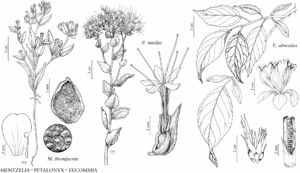Difference between revisions of "Eucommia ulmoides"
Hooker's Icon. Pl. 20: plate 1950. 1890.
FNA>Volume Importer |
imported>Volume Importer |
||
| (One intermediate revision by the same user not shown) | |||
| Line 31: | Line 31: | ||
|elevation=200–300 m. | |elevation=200–300 m. | ||
|distribution=Ind.;N.Y.;Ohio;Asia (China) | |distribution=Ind.;N.Y.;Ohio;Asia (China) | ||
| + | |introduced=true | ||
|discussion=<p><i>Eucommia ulmoides</i>, first reported as an escape in North America by M. A. Vincent (2002), has been put to many uses, including lumber, firewood, and a medicinal tonic (duzhong or tu-chung) made from the bark (T. Forrest 1995; D. J. Mabberley 2008; C. S. Sargent 1913–1917). Leaf and stem extracts have been shown to have potential medicinal value (H. J. Jeon et al. 1998; Y. Li et al. 1998; K. Metori et al. 1997, 1998; T. Nakamura et al. 1997; Y. Nakazawa et al. 1997). <i>Eucommia ulmoides</i> contains a latex (gutta-percha) that has been used in China for lining oil pipelines, insulating electrical lines, and filling teeth (Mabberley).</p><!-- | |discussion=<p><i>Eucommia ulmoides</i>, first reported as an escape in North America by M. A. Vincent (2002), has been put to many uses, including lumber, firewood, and a medicinal tonic (duzhong or tu-chung) made from the bark (T. Forrest 1995; D. J. Mabberley 2008; C. S. Sargent 1913–1917). Leaf and stem extracts have been shown to have potential medicinal value (H. J. Jeon et al. 1998; Y. Li et al. 1998; K. Metori et al. 1997, 1998; T. Nakamura et al. 1997; Y. Nakazawa et al. 1997). <i>Eucommia ulmoides</i> contains a latex (gutta-percha) that has been used in China for lining oil pipelines, insulating electrical lines, and filling teeth (Mabberley).</p><!-- | ||
--><p><i>Eucommia ulmoides</i> is sometimes used as a street or lawn tree. It is drought resistant, disease-free, and easily propagated by seed or cuttings; it is hardy in USDA Zones 4–7 (M. A. Dirr 1990; A. J. Rehder 1940).</p> | --><p><i>Eucommia ulmoides</i> is sometimes used as a street or lawn tree. It is drought resistant, disease-free, and easily propagated by seed or cuttings; it is hardy in USDA Zones 4–7 (M. A. Dirr 1990; A. J. Rehder 1940).</p> | ||
| Line 56: | Line 57: | ||
|publication year=1890 | |publication year=1890 | ||
|special status=Introduced;Illustrated | |special status=Introduced;Illustrated | ||
| − | |source xml=https:// | + | |source xml=https://bitbucket.org/aafc-mbb/fna-data-curation/src/2e0870ddd59836b60bcf96646a41e87ea5a5943a/coarse_grained_fna_xml/V12/V12_450.xml |
|genus=Eucommia | |genus=Eucommia | ||
|species=Eucommia ulmoides | |species=Eucommia ulmoides | ||
Latest revision as of 19:15, 5 November 2020
Trees to 20 m; bark gray-brown, ridged and furrowed; branchlets brown, hairy when young, becoming glabrate, pith septate. Leaves: petioles 1–2.5 cm; blades elliptical to ovate, 5–20 × 2.5–8 cm, base usually truncate to broadly cordate or cuneate, sometimes oblique, apex acuminate, surfaces hairy when young, soon glabrate; latex strands visible in carefully torn leaf. Staminate flowers: anthers 10–12 mm. Pistillate flowers: pistil 10–12 mm. Samaras brown, 25–32 mm, apex emarginate. Seeds 12–15 × 3 mm. 2n = 34.
Phenology: Flowering (Mar–)Apr.
Habitat: Disturbed woods, fence rows.
Elevation: 200–300 m.
Distribution

Introduced; Ind., N.Y., Ohio, Asia (China)
Discussion
Eucommia ulmoides, first reported as an escape in North America by M. A. Vincent (2002), has been put to many uses, including lumber, firewood, and a medicinal tonic (duzhong or tu-chung) made from the bark (T. Forrest 1995; D. J. Mabberley 2008; C. S. Sargent 1913–1917). Leaf and stem extracts have been shown to have potential medicinal value (H. J. Jeon et al. 1998; Y. Li et al. 1998; K. Metori et al. 1997, 1998; T. Nakamura et al. 1997; Y. Nakazawa et al. 1997). Eucommia ulmoides contains a latex (gutta-percha) that has been used in China for lining oil pipelines, insulating electrical lines, and filling teeth (Mabberley).
Eucommia ulmoides is sometimes used as a street or lawn tree. It is drought resistant, disease-free, and easily propagated by seed or cuttings; it is hardy in USDA Zones 4–7 (M. A. Dirr 1990; A. J. Rehder 1940).
Selected References
None.
